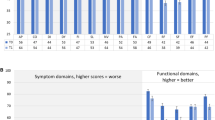Abstract
Introduction Differential item functioning (DIF) analyses can be used to explore translation, cultural, gender or other differences in the performance of quality of life (QoL) instruments. These analyses are commonly performed using “baseline” or pretreatment data. We previously reported DIF analyses to examine the pattern of item responses for translations of the European Organisation for Research and Treatment of Cancer (EORTC) QLQ-C30 QoL instrument, using only data collected prior to cancer treatment. We now compare the consistency of these results with similar analyses of on-treatment and off-treatment assessments and explore whether item relationships differ from those at baseline.
Methods Logistic regression DIF analyses were used to examine the translation of each item in each multi-item scale at the three time points, after controlling for the overall scale score and other covariates. The consistency of results at the three time points was explored.
Results For most EORTC QLQ-C30 subscales, the DIF results were very consistent across the three time points. Results for the Nausea and Vomiting scale varied the most across assessments.
Discussion The results indicated that DIF analyses were stable across each time point and that the same DIF effects were usually found regardless of the treatment status of the respondent.



Similar content being viewed by others
References
Holland, P. W., & Wainer, H. (1993). Differential item functioning. Hillsdale, New Jersey: Lawrence Erlbaum Associates.
Groenvold, M., & Petersen, M. A. (2005). The role and use of differential item functioning (DIF) analysis of quality of life data from clinical trials. In P. Fayers & R. Hays (Eds.), Assessing quality of life in clinical trials (pp. 195–208). Oxford: Oxford University Press.
Teresi, J. A. (2006). Overview of quantitative measurement methods: Equivalence, invariance, and differential item functioning in health applications. Medical Care, 44, S39–S49. doi:10.1097/01.mlr.0000245452.48613.45.
Teresi, J. A. (2006). Different approaches to differential item functioning in health applications: Advantages, disadvantages and some neglected topics. Medical Care, 44, S152–S170. doi:10.1097/01.mlr.0000245142.74628.ab.
Crane, P. K., Gibbons, L. E., Jolley, L., & van Belle, G. (2006). Differential item functioning analysis with ordinal logistic regression techniques. Medical Care, 44, S115–S123. doi:10.1097/01.mlr.0000245183.28384.ed.
Scott, N. W., Fayers, P. M., Bottomley, A., Aaronson, N. K., de Graeff, A., Groenvold, M., et al. (2006). Comparing translations of the EORTC QLQ-C30 using differential item functioning analyses. Quality of Life Research, 15, 1103–1115. doi:10.1007/s11136-006-0040-x.
Scott, N. W., Fayers, P. M., Aaronson, N. K., Bottomley, A., de Graeff, A., Groenvold, M., et al. (2007). The use of differential item functioning analyses to identify cultural differences in responses to the EORTC QLQ-C30. Quality of Life Research, 16, 115–129. doi:10.1007/s11136-006-9120-1.
Schwartz, C. E., & Sprangers, M. A. G. (1999). Methodological approaches for assessing response shift in longitudinal health-related quality-of-life research. Social Science & Medicine, 48, 1531–1548. doi:10.1016/S0277-9536(99)00047-7.
Scott, NW., Fayers, PM., Aaronson, NK., Bottomley, A., de Graeff A., Groenvold, M., Gundy, C., Koller, M., Petersen, MA., & Sprangers, MAG. (2009). A simulation study provided sample size guidance for differential item functioning (DIF) studies using short scales. J Clin Epidemiol 62, 288–295. doi:10.1016/j.jclinepi.2008.06.003.
Fayers, P. M., & Machin, D. (2007). Quality of life. The assessment, analysis and interpretation of patient-reported outcomes. Chichester: John Wiley & Sons.
Acknowledgements
This work was funded by the EORTC Quality of Life Group, Cancer Research UK and the University of Aberdeen and carried out under the auspices of the EORTC Quality of Life Group.
Author information
Authors and Affiliations
Consortia
Corresponding author
Appendices
Members of the Quality of Life Cross-Cultural Meta-analysis Group
Australia: M King, S Leutenegger, N Spry; Austria: E Greimel, B Holzner; Belgium: A Bottomley, C Coens, K West; Brazil: G de Castro, C de Souza; Canada: A Bezjak, M Whitehead; Denmark: M Groenvold, M Klee, M Petersen; France: A Brédart, T Conroy, C Rodary; Germany: M Berend, B Bestmann, M Koller, O Krauß, T Küchler, B Malchow, R Schwarz, S Singer; Greece: K Mystakidou; Iran: A Montazeri; Italy: C Brunelli, M Tamburini; Japan: T Matsuoka, H Zhao; The Netherlands: N Aaronson, A de Graeff, R de Leeuw, M Muller, M Sprangers; Norway: K Bjordal, E Brenne, M Hjermstad, M Jordhøy, S Kaasa, P Klepstad, S Sundstrøm, F Wisløff; Singapore: YB Cheung, SB Tan, J Thumboo, HB Wong; South Korea: YH Yun; Spain: J Arraras; Sri Lanka: H Jayasekara, L Rajapakse; Sweden: M Ahlner-Elmqvist; Switzerland: P Ballabeni, J Bernhard; Taiwan: W–C Chie; Turkey: U Abacioglu; UK: J Blazeby, J Bruce, A Davies, P Fayers, L Friend, Z Krukowski, T Massett, J Nicklin, J Ramage, N Scott, A Smyth-Cull, T Young; USA: D Cella, D-L Esseltine, C Gotay, I Pagano.
Contributing groups
European Organisation for Research and Treatment of Cancer (EORTC) Brain Group, EORTC Breast Cancer Group, EORTC Chronotherapy Group, EORTC Gastro-Intestinal Group, EORTC Genito-Urinary Group, EORTC Gynaecological Group, EORTC Head and Neck Group, EORTC Leukaemia Group, EORTC Lung Group, EORTC Lymphoma Group, EORTC Melanoma Group, EORTC Quality of Life Group, EORTC Radiotherapy Group, EORTC Soft Tissue Group, National Cancer Institute Grant CA60068, National Cancer Institute of Canada (NCIC) Clinical Trials Group, Nordic Myeloma Study Group, Swiss Group for Clinical Cancer Research (SAKK).
Rights and permissions
About this article
Cite this article
Scott, N.W., Fayers, P.M., Aaronson, N.K. et al. Differential item functioning (DIF) in the EORTC QLQ-C30: a comparison of baseline, on-treatment and off-treatment data. Qual Life Res 18, 381–388 (2009). https://doi.org/10.1007/s11136-009-9453-7
Received:
Accepted:
Published:
Issue Date:
DOI: https://doi.org/10.1007/s11136-009-9453-7




